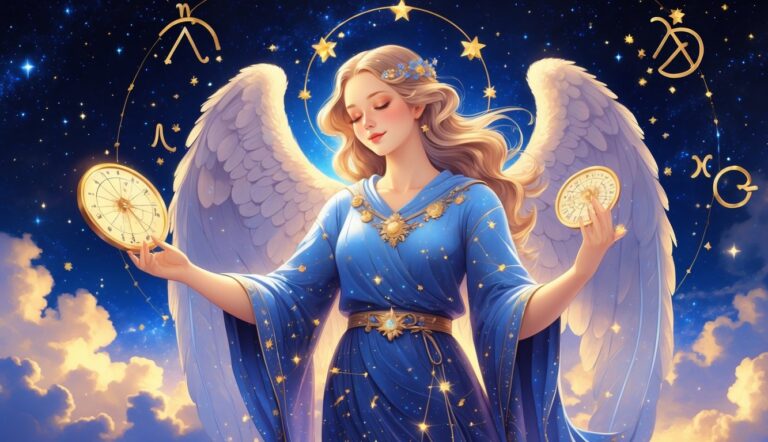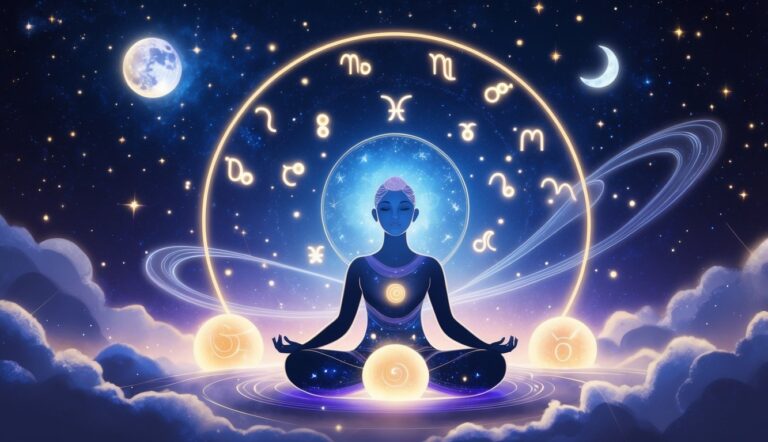Align Your Life with Your True North
The Power Quadrant System decodes your natural talents and pinpoints the career, timing and relationships that let you earn more, love deeper, and wake up eager for the day.
- Uncover your #1 high-income strength
- Draw in partners who raise your energy
- Work when your body’s clock is in “flow”
For millennia, divination has captivated human curiosity.
From ancient oracles to modern tarot readers, people have sought insight into the unknown through various practices.
Divination is the attempt to gain knowledge about the future or hidden matters through supernatural means or the interpretation of signs and omens.
You might be familiar with common forms like astrology or palm reading, but divination encompasses a vast array of methods.
These range from observing natural phenomena to using specialized tools like crystal balls or pendulums.
Each culture has developed its own unique approaches, reflecting diverse beliefs and worldviews.
While skeptics dismiss divination as superstition, many find value in its practice.
Some use it for personal guidance, while others see it as a spiritual or meditative exercise.
Whether you’re a believer or simply curious, exploring divination can offer fascinating insights into human psychology and cultural history.
Key Takeaways
- Divination uses various methods to seek knowledge about hidden or future events
- Different cultures have developed unique divinatory practices throughout history
- Modern divination blends traditional techniques with contemporary metaphysical concepts
Historical Roots of Divination
Divination practices have ancient origins spanning multiple civilizations.
You’ll discover how these methods emerged and evolved across different cultures, shaping beliefs and decision-making for millennia.
Decode Your Personal Success Blueprint
Power Quadrant System shows you the exact career, relationships, and daily rhythm that match your natural DNA—so you earn more, work happier, and connect deeper.
- Pinpoint your #1 money-making talent
- Erase conflict & attract ideal partners
- Multiply productivity with perfect timing
Mesopotamian Beginnings
In ancient Mesopotamia, priests and rulers relied on omens to interpret the will of the gods.
They examined the entrails of sacrificed animals and observed celestial events.
Astrology played a key role.
The Babylonians viewed the stars and planets as divine messengers.
You’d find Jupiter associated with Marduk and Venus with Ishtar.
These celestial bodies were thought to reveal future events and guide important decisions.
Clay tablets from this era show detailed records of divinatory practices.
You’d be amazed at the complex systems they developed for reading signs in nature and daily life.
Divination in Ancient Greece
Greek culture embraced various forms of divination.
Tap Into Your Built-In Success GPS
The Power Quadrant System deciphers your genetic blueprint so you can lock onto the career, income and relationships that feel effortless—and wildly rewarding.
- Zero in on your natural high-earning genius
- Sync with partners who boost your vibe
- Wake up driven, finish days fulfilled
You’d likely visit oracles like the famous one at Delphi to seek guidance.
Priestesses there would enter trances and deliver cryptic messages believed to come from Apollo.
Augury, or interpreting the flight patterns of birds, was common.
You might consult an augur before major undertakings.
Greek generals often used this method before battles.
Dreams held special significance.
You’d find dream interpreters who claimed to unlock hidden meanings in your nighttime visions.
These interpretations could influence personal and political choices.
Etruscan Haruspicy and Augury
The Etruscans, predecessors to the Romans, developed unique divination methods.
You’d be intrigued by their practice of haruspicy – examining animal livers for signs.
Etruscan priests, called haruspices, were experts in this art.
You’d see them carefully inspecting the size, color, and markings on livers to predict future events or divine approval.
Augury was also important in Etruscan culture.
You’d notice priests observing birds’ flight patterns and behaviors to interpret divine messages.
This practice heavily influenced Roman divination techniques.
Asian Perspectives: I Ching and Geomancy
In China, you’d encounter the I Ching or “Book of Changes.” This ancient text uses a system of 64 hexagrams for divination.
You’d toss coins or yarrow stalks to generate these symbols, then interpret their meanings.
Geomancy, known as feng shui in Chinese tradition, examines how energy flows through landscapes and buildings.
You’d consult a geomancer to determine the best locations for homes, temples, or graves.
In Japan, you might participate in omikuji – drawing fortune-telling paper strips at shrines.
Korean tradition includes saju, a form of divination based on your birth year, month, day, and time.
Traditional Divinatory Practices
Ancient cultures developed various methods to seek guidance and glimpse the future.
These practices often relied on natural phenomena, celestial bodies, and everyday objects to derive meaning and predictions.
Ornithomancy and Interpretation of Birds
Birds have long been seen as messengers between worlds.
You might observe their flight patterns, calls, or behavior to gain insights.
In ancient Rome, augurs studied the actions of birds to advise on important decisions.
The direction a bird flew from could indicate favorable or unfavorable outcomes.
Pay attention to unusual bird behavior in your surroundings.
A sudden gathering of crows might suggest upcoming change, while a dove’s appearance could symbolize peace.
Some cultures believe specific birds carry distinct messages – owls for wisdom, eagles for strength.
Cleromancy and Casting of Lots
Cleromancy involves using randomness to divine answers.
You can practice this by casting stones, coins, or dice.
The I Ching, an ancient Chinese divination system, uses coin tosses to generate hexagrams for interpretation.
Try this simple method: Write questions on slips of paper, mix them in a bowl, and draw one blindly.
The selected question may reveal what you need to focus on.
Rune stones offer another option – cast them on a cloth and interpret their positions and symbols.
Astrology: Reading Celestial Bodies
Astrology examines the positions of celestial bodies to understand personal traits and predict events.
Your birth chart, based on the exact time and place of your birth, forms the basis for astrological readings.
Look up your sun sign (based on your birth date) for general personality traits.
Delve deeper by exploring your moon sign (emotional nature) and rising sign (outward personality).
Many find daily horoscopes helpful for guidance, but remember they’re general predictions.
Osteomancy and Divining with Bones
Osteomancy uses bones, often from animals, to seek answers.
You might toss a set of bones and interpret their landing positions.
Some practitioners use specific bones like shoulder blades (scapulimancy) or the breastbone (sternomancy).
To try a simple form, collect small animal bones (ethically sourced).
Cleanse them with sage or sunlight.
Ask a question, then gently toss the bones onto a flat surface.
Note any patterns or formations.
A circular arrangement might suggest completion, while scattered bones could indicate confusion or obstacles.
Modern Metaphysical Methods
Today’s seekers of mystical wisdom have a diverse array of divination techniques at their fingertips.
These methods blend ancient traditions with contemporary insights, offering you unique ways to explore the unseen realms.
Tarot Cards and Cartomancy
Tarot cards remain a popular tool for personal guidance and insight.
The 78-card deck features rich symbolism that can illuminate your path.
When you draw cards, each one reveals potential influences in your life.
Major Arcana cards like The Fool or The Tower represent significant life events.
Minor Arcana suits (Cups, Wands, Swords, Pentacles) cover day-to-day matters.
Other forms of cartomancy use playing cards or oracle decks.
These systems offer simpler symbolism but can be equally powerful for divination.
To start reading tarot:
- Choose a deck that resonates with you
- Learn the basic card meanings
- Practice simple spreads like the 3-card past-present-future layout
Numerology and the Significance of Numbers
Numerology assigns meaning to numbers in your life.
Your birth date, name, and other significant numbers can reveal insights about your personality and life path.
Key numerology concepts:
- Life Path Number (calculated from birth date)
- Expression Number (derived from your full name)
- Soul Urge Number (based on the vowels in your name)
Each number from 1 to 9 carries unique vibrations and characteristics.
Master numbers 11, 22, and 33 hold special significance in numerology.
You can use numerology to gain clarity on your strengths, challenges, and life purpose.
It’s often combined with other divination methods for a fuller picture.
Techniques of Psychic Readers
Psychic readers employ various methods to tap into intuitive information.
These techniques often involve heightened sensory perception or energy reading.
Common psychic abilities include:
- Clairvoyance (clear seeing)
- Clairaudience (clear hearing)
- Clairsentience (clear feeling)
- Claircognizance (clear knowing)
Some readers use tools like crystal balls or pendulums to focus their abilities.
Others practice automatic writing, channeling messages from spiritual sources.
You might encounter psychics who specialize in mediumship, connecting with departed loved ones.
Others focus on past life readings or future predictions.
Cultural Variations and Interpretations
Divination practices vary widely across cultures, reflecting unique beliefs and traditions.
You’ll find fascinating differences in how societies interpret signs and seek guidance from the unseen.
African Traditions and Zande Divination
In trans-Saharan Africa, divination plays a crucial role in daily life.
The Zande people of Central Africa have a particularly intricate system.
You’ll find their diviners using rubbing boards and posing questions to oracles.
Zande divination often involves consulting ancestors or spirits.
Diviners might interpret natural phenomena or use specialized tools to gain insights.
This practice helps community members make decisions about health, relationships, and social conflicts.
Shamanism and necromancy also feature in some African divination traditions.
These methods aim to connect the living with spirits or the deceased for guidance and problem-solving.
Scandinavian Practices and Årsgång
In Scandinavia, you’ll encounter unique divination practices like årsgång.
This tradition involves walking a specific route on certain holidays to glimpse the future.
Årsgång practitioners believe they can see omens or spirits that reveal coming events.
The practice often takes place on Christmas or New Year’s Eve.
You might walk to a crossroads or church at midnight to receive visions.
This custom blends elements of folklore and Christian traditions.
It reflects the region’s historical connection to nature and the supernatural world.
The Art of Tasseography in Europe
Tasseography, or reading tea leaves, is a popular form of divination in Europe.
You’ll find this practice especially common in countries like the UK, Ireland, and Greece.
To perform tasseography, you drink a cup of loose leaf tea and interpret the patterns left behind.
The shapes formed by the leaves are believed to hold messages about your future.
Symbols in tasseography have specific meanings.
For example, a heart might represent love, while a mountain could signify challenges ahead.
This practice often serves as a social activity, bringing people together for conversation and insight.
Contemporary Divination and Popular Culture
Divination practices have found new life in modern society.
Fortune-telling methods like tarot and astrology have gained widespread appeal, while ancient techniques like water scrying have been revitalized.
Divination in Books, Films, and Media
You’ve likely encountered divination in popular entertainment.
The Ouija board features prominently in horror films, often as a conduit for supernatural forces.
In fantasy literature, crystal gazing and other forms of scrying are common plot devices.
Television shows frequently depict characters with intuitive abilities, using their gifts to solve mysteries or predict future events.
Books exploring real-world divination practices have surged in popularity.
You can find guides on tarot reading, rune casting, and numerology in most bookstores.
Social media platforms have become hubs for sharing daily horoscopes and tarot spreads.
Role of Divination in Modern Spirituality
Many people incorporate divination into their spiritual practices today.
Tarot cards and crystal balls are no longer relegated to fortune-tellers at carnivals.
Many use these tools for self-reflection and personal growth.
Witchcraft has seen a resurgence, with practitioners often using divination as part of their craft.
You can find online communities dedicated to sharing spells and rituals that incorporate various forms of fortune-telling.
Some people turn to divination during times of uncertainty, seeking guidance or comfort.
Others view it as a way to tap into their intuition and explore their subconscious minds.







